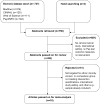Interventions that increase use of Pap tests among ethnic minority women: a meta-analysis
- PMID: 20878847
- PMCID: PMC3741532
- DOI: 10.1002/pon.1754
Interventions that increase use of Pap tests among ethnic minority women: a meta-analysis
Abstract
Objective: Although a variety of intervention methods have been used to promote Pap test screening among ethnic minority women in the US, the effectiveness of such interventions is unclear. We performed a meta-analysis to examine the overall effectiveness of these interventions in increasing Pap test use by ethnic minority women in the US.
Methods: A search of databases (MEDLINE, Cumulative Index to Nursing and Allied Health Literature, PsycINFO, and Science Citation Index-Expanded) and review articles for articles published between 1984 and April 2009 identified 18 randomized and non-randomized controlled trials. The primary study outcome was the difference in the proportion of Pap tests between the treatment and comparison groups.
Results: The pooled mean weighted effect size (d) for the 18 studies was 0.158 (95% confidence interval [CI]=0.100, 0.215), indicating that the interventions were effective in improving Pap test use among ethnic minority women. Among the intervention types, access enhancement yielded the largest effect size (0.253 [95% CI=0.110, 0.397]), followed by community education (0.167 [95% CI=0.057, 0.278]) and individual counseling or letters (0.132 [95% CI=0.069, 0.195]). Combined intervention effects were significant for studies targeting Asian (0.177 [95% CI=0.098, 0.256]) and African American women (0.146 [95% CI=0.028, 0.265]), but not Hispanic women (0.116 [95% CI=-0.008, 0.240]).
Conclusions: Pap test use among ethnic minority women is most likely to increase when access-enhancing strategies are combined. Further research is needed to determine whether more tightly controlled trials of such interventions might reveal an improved rate of cervical cancer screening in Hispanic women as well.
Copyright © 2010 John Wiley & Sons, Ltd.
Figures
Similar articles
-
Breast and cervical cancer screening in obese minority women.J Womens Health (Larchmt). 2006 Jun;15(5):531-41. doi: 10.1089/jwh.2006.15.531. J Womens Health (Larchmt). 2006. PMID: 16796480
-
Sociodemographic predictors of adherence to annual cervical cancer screening in minority women.Cancer Nurs. 2000 Oct;23(5):350-6; quiz 357-8. doi: 10.1097/00002820-200010000-00004. Cancer Nurs. 2000. PMID: 11037955
-
Race-specific results of Papanicolaou testing and the rate of cervical neoplasia in the National Breast and Cervical Cancer Early Detection Program, 1991-1998 (United States).Cancer Causes Control. 2001 Jan;12(1):61-8. doi: 10.1023/a:1008959019019. Cancer Causes Control. 2001. PMID: 11227926
-
Effectiveness of Community Health Worker-Led Interventions in Enhancing Colorectal Cancer Screening Uptake in Racial and Ethnic Minority Populations: A Systematic Review and Meta-analysis.Cancer Nurs. 2024 Sep-Oct 01;47(5):368-376. doi: 10.1097/NCC.0000000000001222. Epub 2023 Mar 31. Cancer Nurs. 2024. PMID: 36927698
-
A meta-analysis of interventions to promote mammography among ethnic minority women.Nurs Res. 2009 Jul-Aug;58(4):246-54. doi: 10.1097/NNR.0b013e3181ac0f7f. Nurs Res. 2009. PMID: 19609176 Free PMC article. Review.
Cited by
-
Effects of a Community Health Worker-Led Multimedia Intervention on the Uptake of Cervical Cancer Screening among South Asian Women: A Pilot Randomized Controlled Trial.Int J Environ Res Public Health. 2019 Aug 23;16(17):3072. doi: 10.3390/ijerph16173072. Int J Environ Res Public Health. 2019. PMID: 31450853 Free PMC article. Clinical Trial.
-
Effects of Community-Based Health Worker Interventions to Improve Chronic Disease Management and Care Among Vulnerable Populations: A Systematic Review.Am J Public Health. 2016 Apr;106(4):e3-e28. doi: 10.2105/AJPH.2015.302987. Epub 2016 Feb 18. Am J Public Health. 2016. PMID: 26890177 Free PMC article.
-
Assessing evidence of interventions addressing inequity among migrant populations: a two-stage systematic review.Int J Equity Health. 2019 May 6;18(1):64. doi: 10.1186/s12939-019-0970-x. Int J Equity Health. 2019. PMID: 31060570 Free PMC article.
-
Effect of culturally tailored education on attendance at mammography and the Papanicolaou test.Health Serv Res. 2020 Jun;55(3):457-468. doi: 10.1111/1475-6773.13271. Epub 2020 Jan 28. Health Serv Res. 2020. PMID: 31994187 Free PMC article.
-
A Randomized Controlled Trial to Increase Cancer Screening and Reduce Depression Among Low-Income Women.J Prev Health Promot. 2022 Aug;3(3):271-299. doi: 10.1177/26320770221096098. Epub 2022 Aug 30. J Prev Health Promot. 2022. PMID: 38566802 Free PMC article.
References
-
- Trans-HHS Cancer Health Disparities Progress Review Group. Making cancer health disparities history. 2009
-
- Miller BA, Kolonel LN, Bernstein L, Young JL, Jr, Swanson GM, West D, Key CR, Liff JM, Glover CS, Alexander GA, et al. Racial/ethnic patterns of cancer in the United States 1988–1992. National Cancer Institute; Bethesda, MD: 1996. NIH Publication No. 96-4104.
-
- Mills PK, Yang RC, Riordan D. Cancer incidence in the Hmong in California, 1988–2000. Cancer. 2005;104:2969–74. - PubMed
-
- Carey P, Gjerdingen DK. Follow-up of abnormal Papanicolaou smears among women of different races. J Fam Pract. 1993;37:583–7. - PubMed
-
- Do TQN. The incidence and prevalence of cervical cancer in Vietnamese women (1993–1995): An analysis of SEER reported cases. Virginia Commonwealth University; Richmond, VA: 2005.
Publication types
MeSH terms
Grants and funding
LinkOut - more resources
Full Text Sources
Research Materials
Miscellaneous


